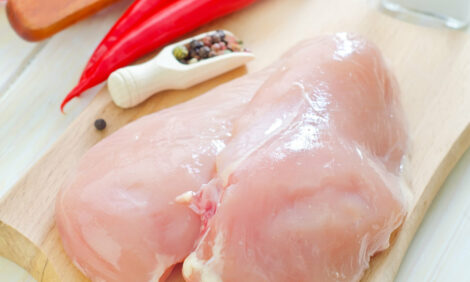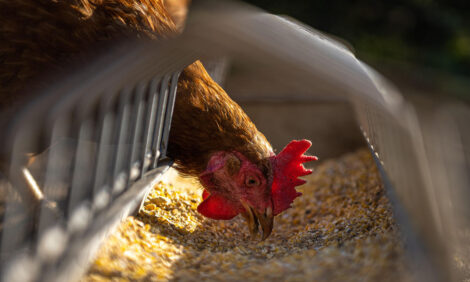



Effect of Drinking Water Chlorination on <i>Campylobacter spp.</i> Colonization of Broilers
By N. J. Stern, M. C. Robach, N. A. Cox, and M. T. Musgroveb - This study compared the rate of intestinal colonization of Campylobacter spp. in chickens provided with chlorinated drinking water against chickens given unsupplemented drinking water, in both experimental and commercial situations.
Effect of Drinking Water Chlorination on Campylobacter spp. Colonization of Broilers - By N. J. Stern,a M. C. Robach,b N. A. Cox,a and M. T. Musgroveb - This study compared the rate of intestinal colonization of Campylobacter spp. in chickens provided with chlorinated drinking water against chickens given unsupplemented drinking water, in both experimental and commercial situations.
M. C. Robach and M. T. Musgroveb - Wayne Farms LLC, 4110 Continental Drive, Oakwood, GA 30566
This study was conducted with broilers first using experimental conditions (isolation units) and second under commercial conditions. We compared the rate of intestinal colonization in chickens provided with 2 to 5 parts per million (ppm) chlorinated drinking water in relation to the frequency of colonization in chickens given unsupplemented drinking water.
No significant difference (P > 0.05) was detected in isolation frequency or level of Campylobacter spp. colonization in birds provided chlorinated drinking water and control birds provided water without supplemental chlorine. In the isolation unit experiments, 86.3% (69/80) of the control and 85.0% (68/80) of the treated birds were colonized at levels corresponding to an average of 105.2 and 105.1 log colony-forming units (cfu) Campylobacter spp./g of cecal contents, respectively.
Additionally, two sets of paired 20,000 bird broiler houses, with and without chlorination (2–5 ppm chlorine), were monitored in a commercial field trial. Effectiveness of chlorination was judged by prevalence of Campylobacter spp. in fecal droppings (960 samples) taken from the flocks in treated and control houses. Birds from the control houses were 35.5% (175/493) Campylobacter spp. positive, while 45.8% (214/467) of the samples from the houses having chlorinated drinking water yielded the organism.
Chlorination of flock drinking water at the levels tested in this study was not effective in decreasing colonization by Campylobacter spp. under commercial production practices presently used in the United States.
Source: Avian Diseases: Vol. 46, No. 2, pp. 401–404. - (2001)
AUTHORS
N. J. Stern and N. A. Cox - USDA—Agricultural Research Service, Richard B. Russell Agricultural Research Center, Poultry Microbiological Safety Research Unit, 950 College Station Road, Athens, GA 30604-5677M. C. Robach and M. T. Musgroveb - Wayne Farms LLC, 4110 Continental Drive, Oakwood, GA 30566
ABSTRACT
The main source for Campylobacter spp. transmission from the environment to broiler chickens is still unclear. One implicated reservoir for the organism has been untreated broiler drinking water.This study was conducted with broilers first using experimental conditions (isolation units) and second under commercial conditions. We compared the rate of intestinal colonization in chickens provided with 2 to 5 parts per million (ppm) chlorinated drinking water in relation to the frequency of colonization in chickens given unsupplemented drinking water.
No significant difference (P > 0.05) was detected in isolation frequency or level of Campylobacter spp. colonization in birds provided chlorinated drinking water and control birds provided water without supplemental chlorine. In the isolation unit experiments, 86.3% (69/80) of the control and 85.0% (68/80) of the treated birds were colonized at levels corresponding to an average of 105.2 and 105.1 log colony-forming units (cfu) Campylobacter spp./g of cecal contents, respectively.
Additionally, two sets of paired 20,000 bird broiler houses, with and without chlorination (2–5 ppm chlorine), were monitored in a commercial field trial. Effectiveness of chlorination was judged by prevalence of Campylobacter spp. in fecal droppings (960 samples) taken from the flocks in treated and control houses. Birds from the control houses were 35.5% (175/493) Campylobacter spp. positive, while 45.8% (214/467) of the samples from the houses having chlorinated drinking water yielded the organism.
Chlorination of flock drinking water at the levels tested in this study was not effective in decreasing colonization by Campylobacter spp. under commercial production practices presently used in the United States.
Source: Avian Diseases: Vol. 46, No. 2, pp. 401–404. - (2001)








